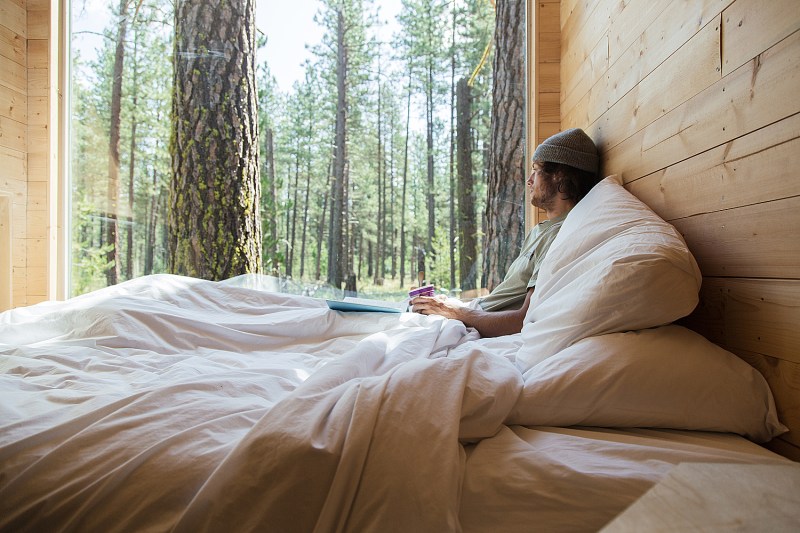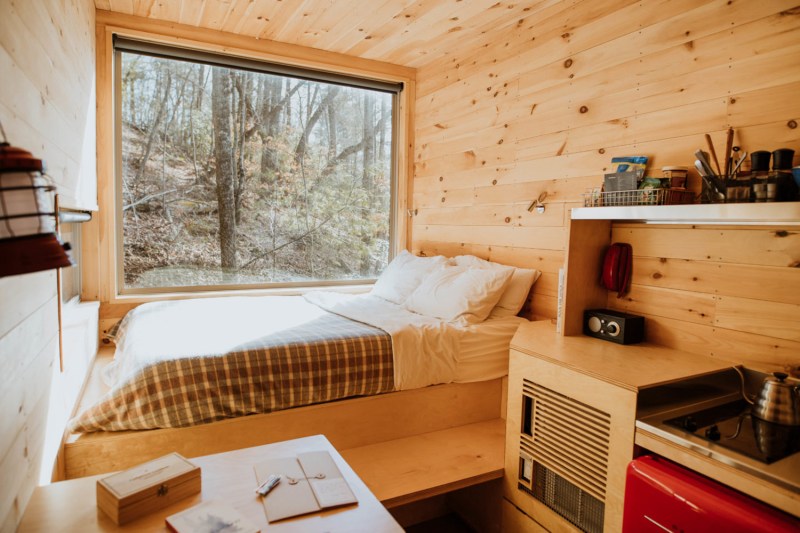
Drive northwest of Nashville, skirt along the Kentucky border, pray your GPS doesn’t fail, and in about two hours you’ll arrive at Getaway Dale Hollow
You’ll follow your screen-grabbed campground map past site after site (Dale Hollow holds 50 of these tiny home spaces in over 400 acres of forest) to arrive at your home for the weekend. You park, pull your modest belongings from the car, and walk over the crushed gravel clearing. Listen: nothing. This is a preview of your days to come.
Related Guides
- Best Places to Book Travel and Vacation Rentals
- Want to Travel in 2021 or 2022? Start Planning
- Best Log Cabin Rentals
Getaway, which was founded in 2015 and appeared on Shark Tank in 2017’s season eight, is now a national brand, with 14 locations open or opening soon that span the U.S. While my experience was with its near-Nashville property, they all operate under a similar principle: Drive two hours from your big metro area, with all its real and imagined stressors, lock up your phone in a dedicated on-site box, and spend a few days like Nirvana’s MTV Unplugged — with electricity, but without all the distortion.
How I Spent A Nature-Filled Day and Night at Getaway

Unlike state or national campgrounds, which cram campsites together like its domestic airline seating, Getaway’s philosophy manifests in generous distance between the spaces. You’re not so remote as to fool yourself into believing you’re the only one here, but you’re far enough where you’re not tempted to call back and forth to other visitors. Getaway is about being alone, whether that’s by yourself, with another, or with a like-minded couple. Campsites are restricted to four people, max, and outdoor music and loud conversations are expressly prohibited, supposedly enforced by park staff who issue $100 “citations,” the profits of which are donated to local conservation groups.
Each plot includes a fire pit complete with cooking grate, picnic bench, two or four chairs (the number depending on your number of beds), and that’s it. It is minimalist in the truest sense of the word: Little, beyond running water, air conditioning, and electricity, is provided and nothing electronic is encouraged. There is no Wi-Fi or TV; even cell service is unlikely, so bring a book or borrow one of Getaway’s from its modest library if you want a fictional escape.
Your “cabin” is one of the finer-designed tiny homes this writer has ever been inside. Granted, it’s on wheels like most other small structures, but it’s far from constricting, and the space only seems to grow in size the farther in you go (credit the Eastern White Pine interior, which keeps everything light and airy, and a gradually heightening ceiling toward its back bedding area). There’s a small table and a two-burner electric range, a small kitchen sink and food prep area complete with a modest selection of plates and utensils (including basic spices), a dorm-size refrigerator, and a full bathroom with shower and toilet. But the focal point is its bed.
I mean, just look at these photos. In the two-person cabins, a queen mattress is covered in crisp white linens and soft pillows. (Double queens are also available and structured in a bunk-bed style for groups of four.) The bed abuts an expansive picture window, which might also accurately be referred to as a see-through wall, since it covers the entire fourth side of the structure. In the cabin I stayed in, we had an obscured view across a forested draw, but the verdant spring foliage was literally pressed against the glass and, at night, shadowy 80-foot-tall tree trunks were overlaid against a full-moon sky. Rather than an aquarium-like feeling, it was a low-excitement nature show, surprisingly satisfying.
The evenings at Getaway are the best. Around five o’clock, we’d start a fire, and by half-past, we’d have a good bed of red coals on which to cook. I’d push them under the grate at the back of the fire pit and place two foil-wrapped potatoes among the embers, where they’d hiss from the rinse water inside. And then it was all waiting: fix a cocktail, lounge back in the Adirondack, smoke a cigar, read Larry McMurtry’s Comanche Moon.
Check the potatoes at 20, 30, 40, and finally 50 minutes, and with the potatoes removed, I’d lower the grate and shovel more coals underneath. Two nice steaks (a ribeye and a New York strip from Porter Road Butcher) sizzled for two or three minutes a side. Brussel sprouts, sealed within a tinfoil pouch with butter, steamed next to the meat. We ate the whole thing on the picnic table on enamel plates, enjoying a couple of Black Abbey beers while the sun set somewhere beyond the trees. After, we roasted complimentary s’mores over the coals and threw more wood to enjoy the lapping flames until retiring early to read in bed. They were good nights.
Read more: When to Book Your National Campsite
The Need to See and Talk to More People While Staying True to Getaway’s Core Message
Getaway was originally pitched to Mark Cuban and the rest of the Sharks as a means of disconnecting from the everyday bustle of modern city life. The Sharks all passed, which was a grievous mistake, as the company has now raised over $160 million over the last six years, boasts a 95% booking rate, and touts its 70% Millennial clientele. But after the last year of coronavirus lockdown, it pivoted its messaging to emphasize itself as a socially distanced vacation. It will have to pivot again.
With easy access in the States to vaccinations and updated CDC guidelines permitting group gatherings, many, including myself, are looking toward the bustle again. I want to see people. Indeed, while I enjoyed the remote feeling that Getaway provides, I felt myself, during evening walks, wanting to drop by neighboring campsites and chat with fellow campers. That coupled with a new, white Jeep and “Just Married” scrawled across the rear window. An older couple, which was unusual for such a youth-focused startup. And then there were the guys at the campsite next to us who had a Very Good Boy that definitely wanted to say hello (Getaway is dog-friendly). But I did not, and everyone seemed to stay true to the spirit of the campground. We remained alone, together.
A maintenance worker I spoke with offered several suggestions for breakfast and dinner spots in the nearby town of Celina, population 1,495. But driving 20 minutes to do something even as innocuous as going for a hike, a swim, or a legendary bakery’s kolach seemed countervailing to the Getaway spirit. So we hunkered down. Two “nature trails” on the grounds still bore the scars from the bulldozers that cut them, and both seemed to end abruptly, as if they’d been abandoned more than completed. I’m grateful I brought a couple of books, because there wasn’t much more to enjoy.
Getaway, when viewed in a certain light, is a one-trick pony. It was conceived during better days, in the raucous pre-pandemic mid-’10s when tiny houses were a national obsession. Even after that enthusiasm waned, its unplugged conceit still had plenty of legs. And in the future, with a renewed economy and lower unemployment, it will once again have its place as guys like me work themselves to the bone and just want to leave it all behind for a few days.
But right now, in 2021, I feel like I’ve already spent 15 months in the wilderness. And now it’s spring, and I’m looking forward to being out. Fully enjoying Getaway takes a certain mindset that I confess I didn’t always have throughout my stay. Would I do it again? Certainly. Give me a year of too much work, too many flights, and a sweaty summertime music festival or two, and I’ll be ready to revisit. Right now, I’m not so sure.




